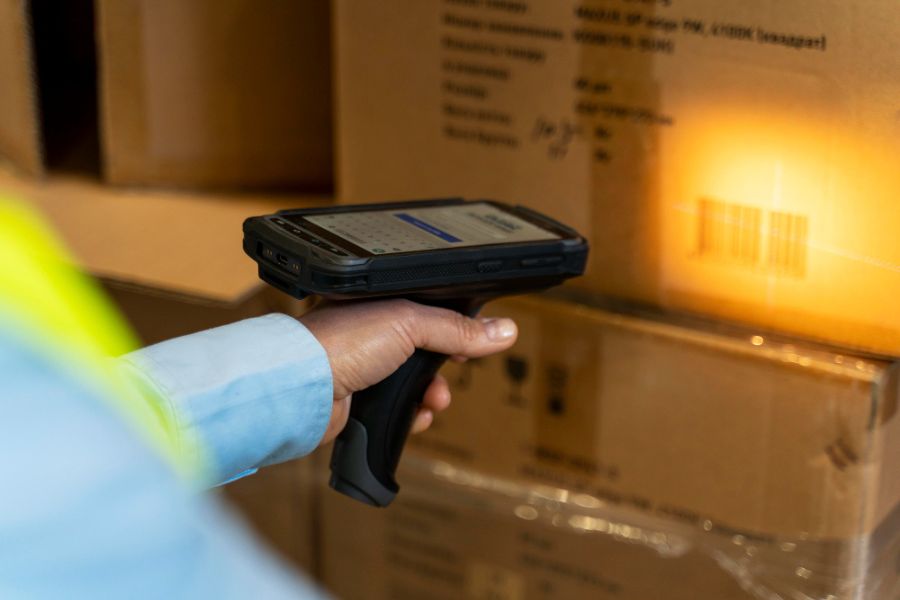To achieve maximum efficiency and improve stock control, businesses are turning to advanced technologies like RFID based inventory management systems. Unlike traditional methods, these systems offer real-time tracking, reduce human errors, and enhance overall operational efficiency. This article provides a comprehensive comparison between RFID technology and traditional inventory management, highlighting their benefits, challenges, and impact on business operations. By the end of this blog, you will understand how adopting RFID technology can transform inventory management and drive business success.
Highlights
- RFID technology improves inventory management with real-time tracking, enhanced accuracy, and greater operational efficiency.
- RFID allows for bulk scanning without line-of-sight, which reduces labor costs and processing time compared to traditional methods.
Traditional Inventory Management Methods Prior to RFID
Traditional inventory management methods have been the backbone of business operations for many years. These popular traditional methods include:
Manual Tracking and Stocktaking
Manual tracking and stocktaking are among the oldest methods of inventory management. This approach involves physically counting items in stock and recording the quantities on paper or in a spreadsheet. It’s often seen in small businesses and retail stores where inventory volumes are manageable.
The primary advantage of manual tracking is its simplicity and low cost. It requires minimal technology, making it accessible to businesses with limited resources. However, this method is highly labor-intensive and prone to human error. Mistakes in counting or recording can lead to discrepancies in inventory levels, resulting in overstocking or stockouts.
Additionally, manual stocktaking can be time-consuming, diverting valuable resources away from other critical business operations.
Barcode Systems
The introduction of barcode systems revolutionized traditional inventory management by automating the tracking process. Barcodes are unique identifiers assigned to each product, and they can be scanned using barcode scanners or mobile devices equipped with barcode scanning capabilities.
Barcode systems offer significant advantages over manual tracking. They enhance accuracy by reducing human error in data entry, speeding up the stocktaking process, and providing real-time inventory updates. This method allows businesses to track inventory movements efficiently, monitor stock levels, and generate detailed reports.
Despite their advantages, barcode systems have initial setup costs for purchasing scanners and printing barcode labels. They also require ongoing maintenance and occasional system upgrades. However, the investment is often justified by improvements in inventory accuracy and operational efficiency.
Inventory Management Software
Inventory management software represents a more advanced and integrated approach to traditional inventory management. These software solutions offer comprehensive tools for tracking, managing, and optimizing inventory levels. They often include features such as automated reordering, demand forecasting, supplier management, and detailed analytics.
►►► Optimal solution set for businesses: Multi store POS, Next-gen POS, Inventory Management Software (MSI), Self Service, Automation, Backorders
One of the key benefits of inventory management software is its ability to centralize and streamline inventory operations. Businesses can access real-time data on stock levels, sales trends, and order statuses from a single platform. This level of visibility enables better decision-making, reduces the risk of stockouts, and minimizes excess inventory. Moreover, inventory management software can be integrated with other business systems such as accounting, e-commerce platforms, and point-of-sale systems, creating a cohesive and efficient workflow.
However, the implementation of inventory management software can be complex and requires a significant upfront investment. Businesses need to choose the right software that aligns with their specific needs and budget.
The Impact of RFID Based Inventory Management System
What if we had a way to track items faster and more accurately than ever before? Perhaps that one question led to the invention of RFID (Radio Frequency Identification) technology.
As businesses strive to optimize their operations and enhance accuracy, the RFID based inventory management system becomes a powerful alternative to traditional methods. RFID technology offers significant improvements in tracking, efficiency, and overall inventory control.
RFID uses electromagnetic fields to automatically identify and track tags attached to objects. These tags contain electronically stored information that can be read from a distance without requiring a direct line of sight.
RFID systems are composed of 3 main components:
- RFID Tags: These small devices can be either passive (no power source, activated by a reader) or active (with a power source, capable of transmitting signals). Each tag contains a unique identifier and, in some cases, additional data about the item it is attached to.
- RFID Readers: These devices emit radio waves and receive signals back from the RFID tags. Readers can be fixed (placed at strategic points like entry/exit points or conveyor belts) or handheld (used for manual scanning).
- Host System: This is the central software that processes the data collected by the RFID readers, integrating it into the broader inventory management system.
RFID technology operates in various frequency ranges, with different applications suited to each range. For example, low-frequency RFID is commonly used for animal tracking, while ultra-high-frequency RFID is preferred for supply chain management due to its longer read range and faster data transfer rates.
Besides that, RFID technology has many benefits such as:
- Improved accuracy: RFID systems significantly reduce human error in manual counting and barcode scanning. Automated data capture means that inventory records are consistently accurate, reflecting real-time stock levels and reducing discrepancies.
- Real-time tracking: One of the standout features of RFID technology is its ability to provide real-time inventory tracking. This enables businesses to have up-to-date information on stock levels, movements, and locations, which is crucial for making informed decisions and responding promptly to changes in demand.
- Higher efficiency: RFID technology streamlines inventory management processes by eliminating the need for manual counting and barcode scanning. Inventory audits are conducted more quickly, and the time and labor required for inventory management are significantly reduced.
- Strengthen security: RFID tags help improve security by tracking the movement of inventory within a facility. This can help prevent theft and loss, as well as provide valuable data on how inventory is used and moved.
- Cost savings: While the initial investment in RFID technology can be significant, the long-term benefits include reduced labor costs, lower error rates, and better inventory management. These savings can quickly offset the initial expenditure.
ConnectPOS is a point-of-sale software that includes a powerful inventory management system supporting RFID technology. Integrating cutting-edge RFID technology, ConnectPOS offers businesses a comprehensive system that enhances inventory accuracy, provides real-time tracking, and improves overall operational efficiency. With user-friendly interfaces and scalable solutions, ConnectPOS is suitable for businesses of all sizes, helping them stay competitive in a fast-paced market.
RFID Based Inventory Management vs Traditional Systems
It is a well-known fact that the tools and methods utilized for stock tracking can greatly impact a business’s efficiency and profitability. Traditional systems such as barcode scanning and manual entry have long been the standard.
However, the rise of RFID technology is transforming inventory management. Comparing RFID-based inventory management systems with traditional systems reveals key differences in accuracy and efficiency, cost implications, scalability and flexibility, and user experience and training.
Accuracy and Efficiency
RFID technology greatly enhances the accuracy and efficiency of inventory management. Unlike traditional barcode systems, which require direct line-of-sight scanning of each item, RFID tags can be read from a distance and without line-of-sight. This allows for quicker and more accurate inventory counts, reducing human error and the time spent on stock-taking.
Traditional systems, while reliable, often suffer from manual entry errors and slower processing times, leading to potential discrepancies in inventory records.
Cost Implications
The initial cost of setting up an RFID based inventory management system can be higher due to the price of RFID tags, readers, and infrastructure. Yet, the long-term benefits, such as reduced labor costs, fewer errors, and improved inventory accuracy, can offset these initial expenses.
While cheaper to set up, traditional systems may incur higher ongoing costs related to manual labor and error correction.
Businesses must weigh upfront costs against potential long-term savings when choosing between these systems.
Scalability and Flexibility
RFID systems offer superior scalability and flexibility. They can handle large volumes of inventory and are easily adaptable to different environments, from small retail stores to large warehouses. RFID tags can also store more information than barcodes, providing additional data points for inventory management.
Traditional systems can become cumbersome and less efficient as inventory volumes grow, making them less suitable for businesses looking to scale up their operations quickly.
User Experience and Training
Implementing RFID based inventory management system can initially be challenging due to the need for specialized equipment and training. Employees must be trained to use RFID readers and understand the system’s capabilities. But once in place, the system can streamline operations and improve overall user experience with faster and more accurate inventory management.
Traditional systems, familiar to most employees, require less initial training but may lead to frustration over time due to their slower and more error-prone processes.
| Aspect | RFID Based Inventory Management System | Traditional Inventory Management System |
| Accuracy and Efficiency | Reads tags from a distance without line-of-sight, reducing errors and speeding up counts. | Requires direct scanning, prone to errors and slower. |
| Cost Implications | Higher initial cost, long-term savings from reduced labor and fewer errors. | Lower initial cost, higher ongoing costs for labor and corrections. |
| Scalability and Flexibility | Scales easily, adapts to various environments, and stores more information. | Becomes less efficient as inventory grows. |
| User Experience and Training | Needs specialized training, but improves speed and accuracy. | Less training needed, but slower and error-prone over time. |
FAQs: RFID Based Inventory Management System
- What are the main advantages of an RFID based inventory management system over traditional methods?
An RFID based inventory management system offers several advantages, including the ability to read tags from a distance without line-of-sight, reducing human error, and speeding up inventory counts. It also provides real-time tracking, improves accuracy, and enhances operational efficiency.
- Are there any significant cost differences between RFID systems and traditional inventory management methods?
Yes, RFID systems typically have higher initial setup costs due to the price of tags, readers, and infrastructure. However, they can lead to long-term savings through reduced labor costs, fewer errors, and improved inventory accuracy. Traditional methods have lower initial costs but higher ongoing expenses for labor and error correction.
- How do RFID systems improve scalability and flexibility compared to traditional methods?
RFID systems are highly scalable and can easily adapt to different environments, from small retail stores to large warehouses. They handle large volumes of inventory efficiently and store more information than barcodes. Traditional methods can become cumbersome and less efficient as inventory volumes grow, making them less suitable for businesses looking to scale quickly.
Conclusion
In sum, RFID based inventory management system offer significant advantages over traditional methods, including enhanced accuracy, real-time tracking, improved efficiency, and better security. While the initial costs may be higher, the long-term benefits such as reduced labor costs and fewer errors make RFID an attractive option for businesses looking to optimize their inventory management processes.
Traditional methods, though simpler and more familiar, often lack scalability and efficiency as businesses grow. For businesses seeking to stay competitive and streamline their operations, adopting RFID technology is a forward-thinking choice.
ConnectPOS delivers comprehensive RFID-based inventory management solutions tailored to businesses of all sizes, guaranteeing precise, real-time inventory tracking and overall efficiency. Contact us today to learn how our solutions can benefit your business.
►►► Optimal solution set for businesses: Shopify POS, Magento POS, BigCommerce POS, WooCommerce POS, NetSuite POS, E-Commerce POS



